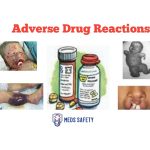Top 10 Causes Of Adverse Drug Reactions

Adverse Drug Reactions (ADRs), also known as adverse drug events (ADEs) or adverse drug effects, are harmful and unintended responses or side effects caused by the use of medications, whether prescribed by a healthcare professional or purchased over the counter. These reactions can occur at normal therapeutic doses and are distinct from the intended effects of the drug.
ADRs can vary widely in terms of severity, ranging from mild and tolerable side effects, such as nausea or dizziness, to more severe and potentially life-threatening reactions. Some common examples of adverse drug reactions include:
1. Allergic reactions: These can include skin rashes, itching, hives, swelling, or, in severe cases, anaphylaxis, a potentially life-threatening condition.
2. Gastrointestinal issues: Medications may cause stomach upset, diarrhea, constipation, or other digestive problems.
3. Central nervous system effects: Some drugs can lead to dizziness, drowsiness, or cognitive impairment.
4. Cardiac and cardiovascular effects: ADRs may include changes in heart rate, blood pressure, or rhythm.
5. Hematological effects: Certain drugs can affect the blood, leading to conditions like anemia, thrombocytopenia, or neutropenia.
6. Hepatic and renal toxicity: Some medications may cause liver or kidney damage.
7. Teratogenicity: ADRs during pregnancy can result in birth defects, developmental issues, or other complications in the fetus.
8. Drug-drug interactions: When two or more drugs interact in a way that causes unintended effects or reduces the effectiveness of one or more drugs.
Types Of Adverse Drug Reactions
Adverse drug reactions (ADRs) are often classified into different types, commonly labeled as A, B, C, D, and E, based on their characteristics and causative factors:
1. Type A (Augmented) Reactions:
• Type A reactions are the most common ADRs and are typically dose-dependent and predictable. These reactions are an extension of the pharmacological actions of the drug.
• Example: Gastrointestinal irritation, such as nausea and ulcers, caused by non-steroidal anti-inflammatory drugs (NSAIDs) like ibuprofen.
2. Type B (Bizarre) Reactions:
• Type B reactions are unpredictable and not dose-dependent. They often result from an individual’s unique sensitivity to the drug or an immunological response.
• Example: Anaphylaxis, a severe and life-threatening allergic reaction to a drug like penicillin.
3. Type C (Chronic) Reactions:
• Type C reactions occur with long-term use of a drug and are often associated with cumulative dose-related toxicity.
• Example: Chronic kidney damage from prolonged use of certain pain medications like high-dose acetaminophen.
4. Type D (Delayed) Reactions:
• Type D reactions manifest after a considerable time following drug administration. They may result from prolonged exposure or delayed pharmacological effects.
• Example: Cancer or other long-term adverse effects caused by drugs, such as some chemotherapeutic agents or hormone replacement therapy.
5. Type E (End-of-Treatment) Reactions:
• Type E reactions occur after discontinuation of a drug and are often related to withdrawal effects or alterations in the body’s physiology after stopping the medication.
• Example: Rebound hypertension when discontinuing certain antihypertensive medications, such as beta-blockers.
These classifications help healthcare professionals and researchers understand and categorize ADRs, which can aid in diagnosis, treatment decisions, and further research into drug safety and efficacy. However, it’s important to note that not all ADRs neatly fit into these categories, and there can be overlapping or multifactorial causes for some reactions.
10 Causes of Adverse Drug Reactions
Adverse drug reactions (ADRs) can occur for various reasons, and they are not always easy to predict. Here are ten common causes of adverse drug reactions:
1. Pharmacological Effects: Sometimes, ADRs occur as a result of the expected pharmacological actions of the drug, particularly when the drug’s dose is too high or its effects are too intense. For example, excessive bleeding caused by anticoagulants.
2. Idiosyncratic Reactions: These are unpredictable and often result from an individual’s unique sensitivity to a drug. Idiosyncratic ADRs are not related to the drug’s dose. An example is severe allergic reactions (Type B reactions).
3. Drug-Drug Interactions: Some drugs can interact with each other, leading to unexpected ADRs. For instance, combining a medication that prolongs the QT interval with another that does the same can increase the risk of life-threatening arrhythmias.
4. Drug-Food Interactions: Certain foods or dietary components can interfere with the absorption or metabolism of drugs. For instance, grapefruit juice can alter the way the body processes several medications.
5. Patient-Specific Factors: A person’s age, genetics, gender, weight, and overall health can influence how they respond to a drug and the likelihood of ADRs.
6. Cumulative Dose: Some ADRs occur only after prolonged exposure to a medication, where the cumulative dose becomes a factor. Chronic kidney damage from long-term use of NSAIDs is an example.
7. Withdrawal Effects: Stopping certain medications abruptly can lead to withdrawal effects or rebound symptoms. For example, discontinuing antidepressants or benzodiazepines can result in withdrawal symptoms.
8. Medication Errors: Mistakes in prescribing, dispensing, or administration can lead to ADRs. Incorrect dosages, drug mix-ups, or administration errors can all cause harm.
9. Off-Label Use: ADRs may occur when a drug is used for a purpose not approved by regulatory authorities or for a different patient population than originally intended.
10. Patient Non-Compliance: When patients do not take their medications as prescribed (e.g., skipping doses, taking the wrong dose, or not completing a full course of antibiotics), it can lead to treatment failure or unexpected ADRs.
Preventing adverse drug reactions
Preventing adverse drug reactions (ADRs) involves a combination of efforts from healthcare professionals, patients, and the pharmaceutical industry. Here are some key steps to help prevent ADRs:
1. Medication Review and Selection: Healthcare professionals should carefully review a patient’s medical history, including allergies and current medications, to select the most appropriate drug with the least risk of interactions and adverse effects.
2. Dose Individualization: Prescribe medications at the lowest effective dose to reduce the risk of ADRs.
3. Patient Education: Healthcare providers should educate patients about their medications, including proper usage, potential side effects, and the importance of adhering to the prescribed regimen.
4. Medication Reconciliation: Regularly review a patient’s medication list to ensure they are taking the right drugs and that there are no potentially harmful interactions.
5. Monitoring: Healthcare professionals should monitor patients for early signs of ADRs, especially during the initial phase of medication use. Regular check-ups and laboratory tests can be important.
6. Allergy and Sensitivity Assessment: Identify and document any drug allergies or sensitivities in a patient’s medical records, and take these into account when prescribing.
7. Pharmacogenomic Testing: In some cases, pharmacogenomic testing can help identify genetic factors that may affect a patient’s response to certain drugs. This can inform treatment decisions and reduce the risk of ADRs.
8. Adherence to Guidelines: Healthcare providers should adhere to established clinical guidelines and best practices when prescribing medications.
9. Use of Health Information Technology: Electronic health records (EHRs) and computerized physician order entry (CPOE) systems can help reduce medication errors and improve medication management.
10. Patient Involvement: Patients should actively participate in their healthcare by informing healthcare providers about any changes in their condition, any new symptoms, or any over-the-counter medications or supplements they are taking.
11. Avoid Polypharmacy: Minimize the number of medications a patient takes, as polypharmacy increases the risk of ADRs. Rationalizing medication regimens and discontinuing unnecessary medications can help.
12. Adverse Event Reporting: Encourage patients and healthcare professionals to report any unexpected or severe reactions to medications to regulatory agencies, such as the FDA’s MedWatch program. This contributes to ongoing drug safety monitoring.
13. Manufacturing and Labeling Standards: The pharmaceutical industry should adhere to stringent quality control standards and provide clear, comprehensive, and accurate drug labeling.
14. Pharmacist Involvement: Pharmacists play a vital role in preventing ADRs by verifying prescriptions, counseling patients, and identifying potential interactions.
15. Research and Development: Continuous research and development by pharmaceutical companies can lead to the development of safer medications with fewer ADRs.
Preventing ADRs is a shared responsibility, and a proactive, patient-centered approach is crucial. Open and effective communication between patients and healthcare providers is essential for minimizing the risk of adverse drug reactions.
In many countries, healthcare professionals and patients are encouraged to report ADRs to regulatory agencies and pharmacovigilance programs, such as the U.S. FDA’s MedWatch program, to contribute to the ongoing assessment of drug safety. This helps identify and address previously unknown or rare adverse reactions, leading to safer and more informed drug use.





